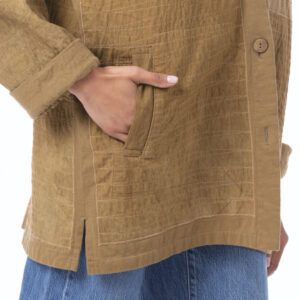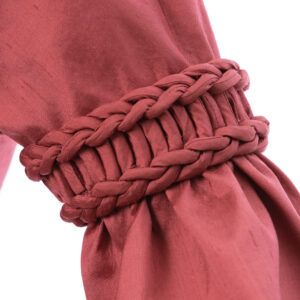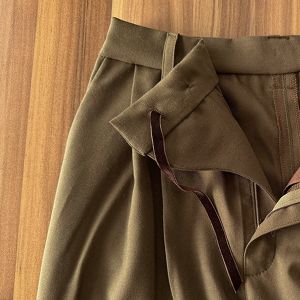New to sewing and looking for ways to do things cheaply – help!
Hi! I’m new to the forums, although I’ve been reading a backlog of Threads articles and user comments eagerly for a little while now. I’m looking forward to trawling through all the advice as I gradually teach myself the proper techniques and lingo to sew well, but in the meantime I have a question I could use some help with.
I’m currently a SAHM with a six month old son, and my partner has been studying these last few months and is now looking for work. While the government in Australia provides financial support to new parents/jobseekers/students, money is still pretty tight. So I’m looking primarily for ways I can save money and still get good results in sewing.
The ideas I’ve encountered so far are things like creating duct tape dress models (I don’t have anyone else to help me fit, so I need a way to do it other than on myself), buying off cuts of fabric on eBay and notions in bulk, etc. I’ve also collected some excellent secondhand references such as Busy Needles magazine and Stitch by Stitch (both British publications from the 70s and 80s that I was lucky enough to find large collections of in thrift shops). Buying second hand patterns is also useful, but I’d love any more suggestions.
-What’s the cheapest way to get fabric? Online or shop hunting? I’m in Australia and while we have a garment district in my city (where you can get fabric wholesale), is online better?
-How about notions?
-Is it worth investing in a couple of machine feet other than my regular zipper and zigzag? Or will they do?
-What are the best blogs/tutorials on the web that I can access for free?
-What are some ways that you’ve saved money over the years, or made clothes on the cheap?
Thanks in advance for your help! I’ll probably be haunting the forums a lot as I start my first projects!
Mandy.



























Replies
new to sewing
I think everyone needs to have basic sewing knowledge. But, It can be very expensive if you just purchasel the supplies for each project as they come up. It takes a little time before your investment begins to pay off. I watch for big sales and buy basic supplies like interfacing/notions that I know I will eventually need. Unfortunately, the places that I used to get fabric at dirt-cheap prices no longer exist in my area. Maybe you are luckier. Check to see if there are any companies in your area that manufacture items made of fabric. They have bolts of left-over fabric and samples. It doesn't have to be a clothing mfg. One of my favorite bargain places was a drapery mfg., Those places also have good buys on zippers and trim.
Although I used to make many items from scratch, I find that in recent years I've saved a lot of money with my sewing knowledge because I can buy ready-to-wear garments that have been reduced way down in price and then alter them to fit much more cheaply than if I made them from scratch. The knowledge you acquire about fabrics, construction, etc., will enable you to recognize a real bargain when you see it.
The most important thing about sewing is learning to fit your body. That should be your goal, in my opinion. No matter how perfectly the garment is "sewn," if it doesn't fit right you won't want to wear it.
Learning to sew is a multifaceted thing. You're going to learn how to use a piece of machinery, you're going to learn how to put fabric together with seams and you're going to learn how to make it fit your body.
I really wasn't very good at first. It wasn't until my daughter was a toddler that I really began to improve. Toddlers are great to sew for! It's almost like making paper doll clothes because you don't have to worry about fitting curves (bust, hips, etc.) And, best of all, since it doesn't take much fabric you don't have the stress of wasting a lot of money if it just doesn't work out. Furthermore, you can do much more creative things with clothes for little children. You can experiment and learn different techniques. You can make cute kids clothes without having to make perfect button holes, etc.
If you are just beginning, maybe it would be fun to learn about your machine and the basics by making some things for your little boy. I wouldn't immediately worry about a dress form, etc. And, in the very beginning, I wouldn't worry about different feet for your machine.
Check your library for books and videos. There are some really good ones.
I'll end with my pet peeve. As you are progressing, don't get caught up in the big promotion of patterns that advertise..Only 2 pcs..or 3 pcs! For some garments they work, (children,) but for others they look skimpy and the fit is awful. Those companies make it sound like seams are evil. No way! Every seam is a place that you can change/mold the shape of the garment and they usually make it easier for you to make the garment fit.
Have fun and come back to tell us how it's going! I
The most important thing about sewing is learning to fit your body. That should be your goal, in my opinion. No matter how perfectly the garment is "sewn," if it doesn't fit right you won't want to wear it.
This is essentially my goal - to understand the construction of garments well enough to draft from scratch, alter commercial patterns and alter ready-to-wear clothing. As a breastfeeding mama I'm having a lot of trouble finding any clothes, anywhere that will fit my post-baby body, particularly my much enlarged bust (at least, without being tent-like everywhere else). I also gained a lot of weight during my pregnancy because I was unable to exercise, and hope to steadily lose this weight within six months - so whatever I sew for myself, I need to keep in mind that the fit must be altered later. Thus I'd like to draft a personal sloper now, and alter patterns to fit myself in a way that they can be taken in as I lose some weight.
This sounds well and good in theory, of course:)
I also have a slew of nephews and nieces to sew for, all three and under. I think you're right, it's a brilliant way to improve technique. I've been collecting little scraps of fabric here and there for a while now too, with the intention of sewing toys and clothing for both them and my son. I've just started a little gingham dress with appliqués for a three year old, and all up I think it will have cost me about five dollars, including some satin bias binding and shell buttons, thanks to the bargain bins at my local fabric store.
Every seam is a place that you can change/mold the shape of the garment and they usually make it easier for you to make the garment fit.
I hadn't thought of it that way before! Thanks so much for your advice, it's all really helpful - and I'll check back in once the current project is a little further along!
Mandy.
One of the best blogs I've come across has been ikatbag http://www.ikatbag.com/ There is a lot more to sewing than sewing clothes. I learned to sew by sewing Barbie doll clothes. Sewing quilts and pillows are a great way to learn how to sew straight seams. Start with the basics--good fabric scissors (never cut paper with them), pins, something to mark with (#2 lead pencil, chalk pencils, chalk, tracing paper, etc. are all good), tape measure, 6" sewing gauge or ruler, hand and machine needles, good iron. As your skill level rises, you will acquire more tools. As for sewing machine feet goes, a all-purpose (zig-zag) foot and a zipper foot with maybe the addition of a buttonhole foot are all you need to start with. And those feet usually come with the machine. Over time, you can buy additional feet. One of the best sewing books I have is The Bishop Method of Clothing Construction by Edna Bryte Bishop from the 50s/60s. It is out of print but you can still buy copies on Amazon. I bought mine at the book store in my local library. It's a basic sewing course in book form. For inexpensive fabrics, buttons,etc. browse your local thrift stores. Sheets, items of clothing, even pieces of fabric can be had cheap. Large size clothing can be cut up for children's clothes, quilts. Buttons can be salvaged from clothing.
Chris
Getting into sewing
I'm glad to hear that you're interested in taking up sewing, but let me warn you: it's NOT cheaper to make your own clothes from scratch anymore! Sewing is a useful, valuable, and very interesting skill that can save you a lot of money in alterations, home dec, gifts, children's clothes, and simple skirts and dresses, but even with decades of experience and lots of options for fabric, I cannot make garments for myself for anywhere near the price of items I can get on sale or in outlets.
Children's clothes and simple items like pillow covers, placemats, tote bags, aprons, & pajamas are good projects to start with; they don't take a lot of fabric or special techniques, but you can practice more complex techniques and embellishments on them.
Your two machine feet will do just about anything, but you might want to get an overlock foot if you will be sewing a lot of knits. Be sure to invest in a variety of needles--sizes 9 through 16, ball point, universal, & denim needles will allow you to sew anything from sheer curtains to jackets.
To save money, I've bought over-sized garments at thrift stores and garage sales, torn them apart, and put them back together in my size. Used tablecloths and curtains can also be remade into dresses, skirts, etc.
Do a web search for "re-style tee shirts" or "re-fashion" to find lots of wonderful blogs online. Sewing is very visual, so look for ones with lots of photos. Do a search for "How to make machine buttonholes" or "How to insert a zipper" to find very good tutorials.
Also check your local libraries for sewing magazines and how-to books. Our university library has a whole section of sewing books (from the old Home Economics classes and the current Textiles and Design courses).
Have fun and keep us posted on your progress!
This post is archived.